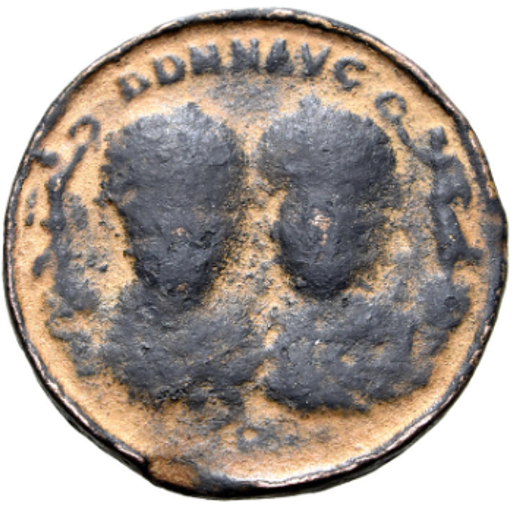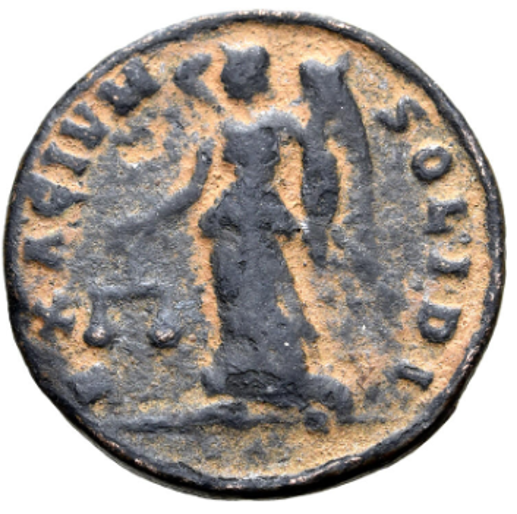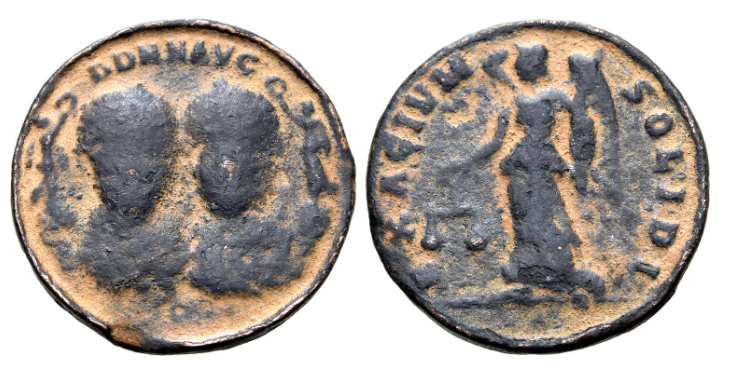
-
Copyright credit: Roma Numismatics Ltd

-
Copyright credit: Roma Numismatics Ltd

-
Copyright credit: Roma Numismatics Ltd

ARCHAEOLOGICAL DESCRIPTION OF THE WEIGHT
Authority
Arcadius, Roman Emperor
;
Honorius, Roman Emperor
Mint
Constantinople
Denomination
1 Nomisma = 1 Solidus
Material
Copper alloy (bronze or brass)
Manufacture
Struck
Shape
Disc or similar (ellipse, etc.)
Length
2.00 cm
Width
2.00 cm
Height
- cm
Metrology
| Mass (g) | Mass (grain) | Date of measurement | Reference | fragmented | cleaned | reference weight |
|---|---|---|---|---|---|---|
| 3.82 | - | - | Auction Roma 2022 | No | No | Yes |
Iconography
| Symbol | Technique | Direction | Position | Number | Synecdoche |
|---|---|---|---|---|---|
| Roman Emperor | Stamped / Countermarked / Struck | FACING | Two | Bust | |
| Aequitas / Justitia / Moneta | Stamped / Countermarked / Struck | LEFT | Standing | One | |
| Nike | Stamped / Countermarked / Struck | LEFT | Standing | One | |
| Balance scale | Stamped / Countermarked / Struck | One | |||
| Globe | Stamped / Countermarked / Struck | One | |||
| Palm tree | Stamped / Countermarked / Struck | One | |||
| Nike | Stamped / Countermarked / Struck | RIGHT | Standing | One |
Wear
Corrosion
Handle
No
Suspension hole
No
Recarved mould
No
Recarved weight
No
Intentionally destroyed
No
Archaeological description
Auction Roma 2022: Lot 1617. Roman Imperial Æ Exagium Solidi Weight. Circa AD 420. DD NN AVG, diademed and draped busts (of Honorius and Theodosius II?) facing, each holding globus surmounted by crowning Victory / EXAGIVM SOLIDI, winged figure of Moneta (partially assimilated to Victory) standing to left, holding scales and palm. Described in RIC X, on p.8 = Sotheby 16 April 1985, 419; Bendall, Byzantine Weights -. 3.82g, 20mm, 1h. Near Very Fine; heavy encrustation. Extremely Rare; no other examples on CoinArchives. From the inventory of a North American dealer. Official solidus weights, based on a standard 'imperial pound', came into being with the law of Julian of AD 363, which established a zygostates - an official weigher of solidi in each city - to restore confidence in the solidus, which had become subject to widespread clipping. Exagium derives from the Latin exigere, "to drive out" - in this case, the underweight solidi, thereby maintaining an acceptable weight standard necessary for the imperial gold coinage to circulate at full value. Many such exagia display holes and/or plugs to bring the exagium to the correct weight, so unmodified exagia (especially examples that are underweight such as the present piece) are thus a rarity.
Asolati 2022: Exagia solidi imperiali con indicazione esplicita della funzione: Arcadio e Onorio, 395-403 d.C., exagium solidi. Zecca di Constantinopolis (?). D/ DD NN AVG; due busti frontali, affiancati, diademati, drappeggiati e corazzati, entrambi con globo niceforo. R/ EXAGIVM SOLIDI; Vittoria come Iustitia (?) stante a s. con bilancia e palma. b. Roma, E-Sale 98 (16/06/2022), lotto n. 1617: g 3,82; mm 20; h 1.
Asolati 2022: Exagia solidi imperiali con indicazione esplicita della funzione: Arcadio e Onorio, 395-403 d.C., exagium solidi. Zecca di Constantinopolis (?). D/ DD NN AVG; due busti frontali, affiancati, diademati, drappeggiati e corazzati, entrambi con globo niceforo. R/ EXAGIVM SOLIDI; Vittoria come Iustitia (?) stante a s. con bilancia e palma. b. Roma, E-Sale 98 (16/06/2022), lotto n. 1617: g 3,82; mm 20; h 1.
Autopsy
No
INSCRIPTION
| Language | Technique | Legend type |
|---|---|---|
| Latin | Stamped / Countermarked / Struck | Authority, Denomination, Legal status |
Fac simile
DDNNAVG
EXAGIVM SOLIDI
Edition
D(ominorum) N(ostrorum) Aug(ustorum). || Exagium solidi.
Monogram
ARCHAEOLOGICAL CONTEXT
Findspot (region)
Findspot (site)
context
CIRCUMSTANCES OF ACQUISITION
Region
City
Date of first acquisition
June 16, 2022
circumstances
Antiquities trade.
DATING OF THE WEIGHT
Curatorial Section
LATE ROMAN AND BYZANTINE
Time frame
FROM
395
TO
420
Comments on Chronology
Auction Roma 2022: suggests a date around 420.
Asolati 2022: suggests a chronological range from 395 to 403.
Asolati 2022: suggests a chronological range from 395 to 403.
COLLECTION HISTORY
Collection
| Name | Date of acquisition | Inventory number |
|---|---|---|
| Antiquities Trade | June 16, 2022 | None |
Bibliography
| Reference | Page/Column | Reference (number) | Plate / Figure | Comment |
|---|---|---|---|---|
| Asolati 2022 | 258 | 6b | None | None |
| Auction Roma 2022c | None | 1617 | fig. | None |
VARIA